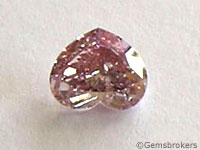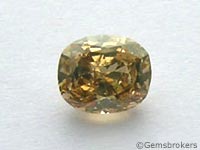- Agate
- Alexandrite
- Amber
- Amethyst
- Aquamarine
- Aventurine quartz
- Bloodstone
- Carnelian
- Cat's eye
- Chrysoberyl
- Chrysoprase
- Citrine
- Coral
- Demantoid garnet
- Diamond
- Emerald
- Garnet
- Iolite
- Labradorite
- Lapis lazuli
- Mandarin garnet
- Moonstone
- Onyx
- Opal
- Peridot
- Rock crystal
- Rose quartz
- Ruby
- Rutile quartz
- Sapphire
- Smoky quartz
- Spinel
- Sunstone
- Tanzanite
- Tiger's eye
- Topaz
- Tourmaline
- Tsavorite
- Turquoise
- Zircon
Diamond

Think only of Marilyn Monroe and her song "Diamonds are a girl's best friend,” or Shirley Bassey and "Diamonds are forever": both these popular modern songs reflect the everlasting fascination that we have for this gem. It would be impossible to give an exhaustive account of it. Here are just some facets of this powerful symbol.
The word diamond comes from the Greek word “adamas” meaning unconquerable or invincible. Interestingly, its Aryan root “dam”, to tame or subdue, is also the basis of the word ”madam”.
The adjective "adamas" was employed to describe the hardest substance known and became synonymous with the gem, in reference to the hardness of this stone made of carbon, a chemical element fundamental to all life, here in its most concentrated form.
We commonly associate with this natural crystalline mineral wealth, prosperity, social status, and love but lightning, magic, healing, protection and poisoning are also evoked in other cultures or in other times.
It will always be the oldest item that anyone can own, from 50 million years old for the most recent deposits to 2.5 billion years for the oldest. Formed more than 100 miles below the surface of the Earth and shot to the surface by volcanoes, it is also a strategic and high-tech material.
The myths and facts associated with the diamond transcends cultures and continents, and the prominence of this stone is inscribed in the Greek, Indian, English, French, German, Hebrew, Latin, Arabic, Japanese, American, African, Korean, Polish, and Chinese cultures, among others.
The world’s first known reference to this gemstone comes from a Sanskrit manuscript, the Arthsastra (which translates as The Lesson of Profit) written by Kautiliya, a minister to Chandragupta of the Mauryan Dynasty (322 BC – 185 BC).
Roman literature makes its first distinct mention of diamonds only in the first century AD, in reference to the alluvial diamonds found in India and Borneo.
The ancient Greeks and Romans believed they were tears of the Gods and splinters from falling stars. Cupids' arrows were supposed to be tipped with diamonds, having thus a magic that nothing else can equal.
Plato wrote about diamonds as living beings, embodying celestial spirits.
 The Hindus believed that they were created when bolts of lightning struck rocks. They even placed some in the eyes of some of their statues.
The Hindus believed that they were created when bolts of lightning struck rocks. They even placed some in the eyes of some of their statues.
Jewish high priests turned to diamonds to decide the innocence or guilt of the accused: a stone held before a guilty person was supposed to dull and darken, while when held before an innocent one to glow with increased brilliance…
The Romans wore diamonds because these were thought to possess broad magical powers over life’s troubles, being able in particular to give to the wearer strength, invincibility, bravery, and courage during battle.
Kings, in old days, led the battles on the battlefields wearing heavy leather breastplates studded with diamonds and other precious stones because it was believed that diamonds possessed God given magical qualities and powers far beyond the understanding of common man. Thus, warriors stayed clear of Kings and those who were fortunate enough to have the magical diamonds in their breastplates.
An act of Louis IX of France (1214-1270) that established a sumptuary law reserving diamonds for the King, which indicates the rarity of this stone and the value conferred on it at that time.
Until the 14th Century only Kings could wear diamonds, because they stood for strength, courage and invincibility. Since then that this gem has acquired its present status as the ultimate gift of love.
Small numbers of diamonds began appearing in the 14th century in European regalia and jewelry, set mainly as an accent point among pearls. But the possession of extraordinarily large and noble diamonds was always the privilege of royal houses and particularly rich families. To give just an example, the imperial crown of the Russian czarina Catherine the Second (1729-1796) was mounted with 4936 sparkling stones.
In the Middle Ages and the Renaissance, every ring set with a precious stone was not considered as much a piece of jewelry, but more as an amulet that bestowed magical powers upon its wearer.
When set in gold and worn on the left side, it was believed that the diamond held the power to drive away nightmares, to ward off devils, phantoms and soothe savage beasts.
A house or garden touched at each corner with a diamond was supposed to be protected from lightning, storms and blight.
Diamonds were also supposed to impart virtue, generosity, as well as to calm the mentally ill and even to determine lawsuits in the wearer's favor.
Not only was it commonly believed that diamonds could bring luck and success, but also that they could counter the effects of astrological events.
Minerals were among the first medicinal ingredients. In the middle Ages, it was believed that a diamond could heal the sick person that took it into his/her bed and warmed it with the body.
Even tough diamonds were worn as a talisman against poisoning, diamond powder administered internally, was however a legendary poison.
The son of the Turkish Sultan Bajazet (1447-1513) was said to have murdered his father pouring a large quantity of powdered diamond in his father's food.
In l532, Pope Clement VII’s doctors dosed him with fourteen spoonfuls of pulverized gems, including diamond, which resulted in death for the patient.
In the same century, Catherine de Medici was famous for dealing out death by diamond powder, and Benvenuto Cellini, the famous Italian goldsmith, described an attempt on his life by an enemy who ordered diamond powder to be mixed in his salad.
The association of diamonds with poison may have been promoted to discourage the practice of stealing diamonds by swallowing them, particularly during mining.
Diamond is the birthstone for the month of April and also the gemstone for the American State of Arkansas.
Some advices to buy a diamond in our Antwerp trading office...




